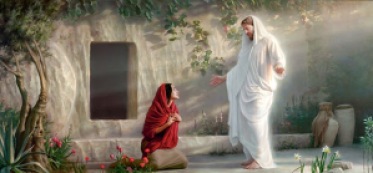 The seeming refusal of Jesus to permit Mary to touch him, followed almost immediately by the appearance in which the other women were permitted to hold his feet, has always been the source of some interpretative concern. The King James Version quotes Jesus as saying ‘Touch me not.’ The Joseph Smith Translation reads ‘Hold me not.’ Various translations from the Greek render the passage as ‘Do not cling to me’ or ‘Do not hold me.’ Some give the meaning as ‘Do not cling to me any longer,’ or ‘Do not hold me any longer.’ Some speak of ceasing to hold him or cling to him, leaving the inference that Mary was already holding him. There is valid reason for supposing that the thought conveyed to Mary by the Risen Lord was to this effect: ‘You cannot hold me here, for I am going to ascend to my Father.'” (Bruce R. McConkie, The Mortal Messiah: From Bethlehem to Calvary, 4 vols. [Salt Lake City: Deseret Book Co., 1979-1981], 4: 264.)
The seeming refusal of Jesus to permit Mary to touch him, followed almost immediately by the appearance in which the other women were permitted to hold his feet, has always been the source of some interpretative concern. The King James Version quotes Jesus as saying ‘Touch me not.’ The Joseph Smith Translation reads ‘Hold me not.’ Various translations from the Greek render the passage as ‘Do not cling to me’ or ‘Do not hold me.’ Some give the meaning as ‘Do not cling to me any longer,’ or ‘Do not hold me any longer.’ Some speak of ceasing to hold him or cling to him, leaving the inference that Mary was already holding him. There is valid reason for supposing that the thought conveyed to Mary by the Risen Lord was to this effect: ‘You cannot hold me here, for I am going to ascend to my Father.'” (Bruce R. McConkie, The Mortal Messiah: From Bethlehem to Calvary, 4 vols. [Salt Lake City: Deseret Book Co., 1979-1981], 4: 264.)
“One may wonder why Jesus had forbidden Mary Magdalene to touch Him, and then, so soon after, had permitted other women to hold Him by the feet as they bowed in reverence. We may assume that Mary’s emotional approach had been prompted more by a feeling of personal yet holy affection than by an impulse of devotional worship such as the other women evinced. Though the resurrected Christ manifested the same friendly and intimate regard as He had shown in the mortal state toward those with whom He had been closely associated, He was no longer one of them in the literal sense. There was about Him a divine dignity that forbade close personal familiarity. To Mary Magdalene Christ had said: ‘Touch me not; for I am not yet ascended to my Father.’ If the second clause was spoken in explanation of the first, we have to infer that no human hand was to be permitted to touch the Lord’s resurrected and immortalized body until after He had presented Himself to the Father. It appears reasonable and probable that between Mary’s impulsive attempt to touch the Lord, and the action of the other women who held Him by the feet as they bowed in worshipful reverence, Christ did ascend to the Father, and that later He returned to earth to continue His ministry in the resurrected state. (James E. Talmage, Jesus the Christ, p. 682.)

“If we are the sons of God, then he is our Father. Christ taught this doctrine to his disciples. ‘I ascend unto my Father, and your Father, and to my God, and your God.’ Does not this mean family organization? Can we be heirs and joint-heirs with Jesus Christ, and not be sons? If sons, then we are members of the family. This is the hope we have in God our Father. O how great is his love for his children!” (Joseph Fielding Smith, The Way to Perfection, 1949, p. 256.)

What then was the actual intention of Mary in her attempt?